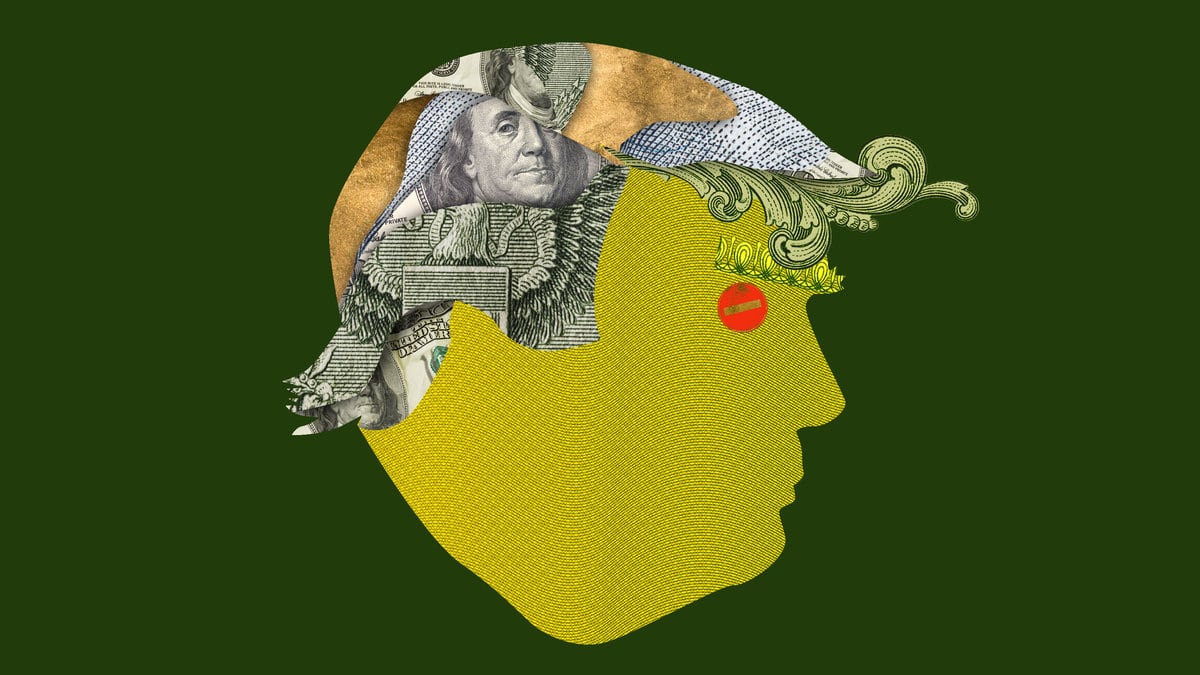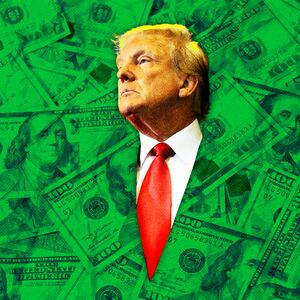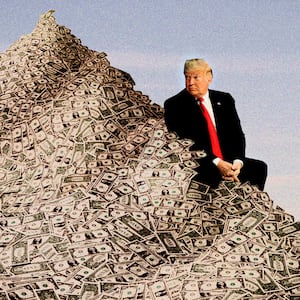Pay Dirt is a weekly foray into the pigpen of political funding. Subscribe here to get it in your inbox every Thursday.
Campaign donor refunds have been a part of political finances since modern contribution limits were first instituted in 1972. But just over 50 years later, Donald Trump’s political operation seems to have found a novel workaround, with the campaign reporting just one individual refund—for $400—over the entirety of last year.
To date, the Trump campaign has reported only $1,400 in refunds since November 2022, according to Federal Election Commission filings—a jaw-droppingly low amount for a frontrunner presidential campaign. For context, President Joe Biden’s campaign refunded its supporters about $360,000 last year, with another $222,000 last month alone. In 2019, the year before the last presidential election, the Trump campaign returned more than $900,000 to its donors, racking up more than $11 million in refunds the following year.
But now, the refunds are essentially zero, raising the prospect of the former president’s campaign once again stretching the bounds of campaign finance law to inflate his war chest—and the public’s impressions of his political strength.
On paper, Trump’s refund rate is virtually impossible. His campaign has not solved this persistent problem of overpayments. His donors are, in fact, breaking the donation limits—dozens and dozens of them, according to the notices that the FEC sent his campaign after every 2023 filing.
So how exactly has the Trump campaign found a way to make the refunds disappear? That question arrives at a sensitive political moment, as numerous news reports pillory the Trump operation for its breakneck spending amid an alarmingly bleak fundraising outlook.
While no one on Trump’s campaign would answer these questions for The Daily Beast—either on the record or on background—there are clues in the campaign’s responses to the FEC’s notices. In those replies, Trump campaign treasurer Bradley Crate acknowledges the excessive donations. He states that the money has since been “returned” to an affiliated committee, which will be “reflected on a subsequent [campaign] report.”
Crate’s answer, it seems, is that the Trump campaign is forwarding the excessive amounts to other political accounts, potentially raising a host of other issues.
But Crate’s explanation, as written, doesn’t seem explicitly true—at least not at the moment.
According to FEC data, the 2024 Trump campaign has never reported sending any money to that affiliated committee, a joint fundraising committee (JFC) called “Trump Save America.” And that committee’s refund rate also appears low—a total $150,000 out of $129 million raised. By comparison, Haley’s JFC refunded roughly $115,000 while raising $20 million. (In 2022, Trump’s JFC returned $42,000, and just $2,500 the year before.)
Trump’s JFC, however, is also torching cash. It shelled out $48.3 million in operating expenses last year, while distributing $80.8 million to the campaign and Save America—a burn rate hovering around 40 percent. It ended the year with a net loss, holding just $3.5 million on hand. Most of those costs are for services typically associated with fundraising—$14.2 million for digital consulting, another $11 million on direct mail, $4.2 million for online solicitation fees, and $3.4 million on texting services. At the same time, Biden’s JFC raised nearly $30 million more, spent $15 million less, and walked away from 2023 with more than 10 times as much cash on hand.
Refunds are also low for Trump’s “Save America” leadership PAC—a legal slush fund that is also a political cash incinerator with a stunning refund rate of nearly zero. While the PAC reported $560,000 in refunds last year, the PAC quietly admitted in letters to the FEC that those were not contemporary. The refunds came from an array of old errors that were caught in an internal audit—with some mistakes dating back more than two years. In 2022, the PAC refunded $770, and in 2021, it refunded $50. It raised about $160 million in that same time.
In 2020, the Trump campaign refunded $11.3 million.
The Trump, Biden, and Nikki Haley campaigns all have JFCs. The Biden and Haley operations fund committees beyond themselves, with broader political imperatives. But Trump Save America only feeds two committees, his campaign and his Save America leadership PAC. The default “split” sends 90 percent of every donation to the campaign, and 10 percent to Save America. Both committees have been raising almost all their money through the JFC.
Typically, if a donor gives a campaign too much money, the campaign refunds the excess amount to the person, reporting it later in FEC filings. But when a donor gives too much to the Trump campaign through this joint committee, the campaign does not refund that person. Instead, The Daily Beast’s analysis of FEC data indicates that some reports appear to have simply vanished the original excessive amount altogether, even though the new amended filings show the exact same bottom line totals, down to the penny.
In short, the arrangement appears to swap out the refund process with a new batch of donations. It clearly requires more work behind closed doors, but the bottom lines remain the same, and at least to that end, it all comes out in the wash, so to speak.
This has come up previously with Trump. In 2020, BuzzFeed News reported the first known illegal foreign contribution to the Trump campaign, from a Turkish national turned MAGAworld influencer. The donation had gone to the campaign through the JFC at the time, called “Trump Victory.” In response to the report, Trump Victory refunded the illicit donation in full. But the campaign itself kept the money—it did not return the cash to Trump Victory, even after months of inquiry. The refunded money came out of other Trump Victory donations.
Notably, the maneuvering also appears to demand at least some degree of misrepresentation to the FEC, if not outright lying—specifically, the treasurer’s written statements that the campaign had “returned” the money when its reports show no such transactions.
Jordan Libowitz, communications director for Citizens for Responsibility and Ethics in Washington, told The Daily Beast that excessive donations shouldn’t be a huge problem to begin with, because JFCs typically pre-screen donations for potential limit-breakers.
“The way this is supposed to work is that the JFC checks for excessive contributions, and with written approval, rebalances the percentages on an excessive contribution to keep it from being excessive,” Libowitz explained, citing FEC rules.
Refunds are typically easy to resolve, through processes the FEC lays out on its website. The available guidance for joint fundraising is thinner, though those rules stipulate that the JFC and participants “must screen all contributions” to ensure they are not in excess of the limits, saying participants “must provide” donor records to facilitate those efforts. The rules appear equally clear that all committees must disclose their refunds, regardless of amount.
“What the Trump campaign appears to have done is said ‘Money is fungible,’” Libowitz said. However, he noted, the Trump campaign’s solution is also its most glaring problem.
“You cannot take $9,900 from one donor and $3,300 from another and claim to have taken $6,600 from each,” he said.
Excessive donations are a common issue for all campaigns. Trump’s top primary opponents forked over hundreds of thousands of dollars, even while raising less money than the former president. Ron DeSantis’ failed presidential campaign kicked back about $535,000, and Haley’s campaign returned more than $260,000. Even dropouts like Tim Scott ($44,000), Chris Christie ($11,000), and Mike Pence ($9,600) all showed higher refunds despite dramatically lagging Trump in fundraising, combined. And the campaign for longshot independent Robert F. Kennedy Jr. sent about $485,000 back to his donors, disclosures show.
The issue is so pervasive that the FEC itself actually notifies committees about any impermissibly large contributions that it discovers in its standard reviews. Last year, the FEC caught excess donations on all of the Trump campaign’s filings, with his last quarterly report racking up a 286-page list of individual donors who apparently gave more than they’re allowed. The donors on that one list alone have given the campaign nearly $470,000 combined, according to the notice, though the excess amounts only make up a partial amount of that total.
But it’s not just a disclosure issue either; campaign refunds also happen to provide an important political metric.
High refund rates can signal potential donor burnout, a financial clue that a campaign has maxed out most of its reliable supporters and might be in danger of going into the red if it can’t find other funding sources. This was the case with the Trump campaign in 2020, when a number of news reports identified small-dollar donor burnout as a problem. Combined with reportedly lavish spending, that left the Trump operation with a massive cash deficit against Biden just ahead of the election.
Today, both Trump and Biden are feeling the pinch—part of a national downward trend that Politico dubbed a “political recession.” But of the two campaigns, Trump’s operation appears to have been hit hardest.
Recent reports have raised alarms about Trump’s runaway legal spending and drooping donations, sparking internal concerns about whether Trump can sustain the necessary financial support through the election.
However, if a campaign doesn’t report refunds, those potential weaknesses are harder to calculate—and harder to report.
Given Trump’s personal financial history, critics may be tempted to assume his campaign is simply lying, holding on to the money and daring the government to do something about it. (The FEC has never taken action against Trump.) That, of course, would be wildly illegal, carrying serious, potentially criminal penalties not just for the campaign, but also for his outside treasurer and the established political accounting firm that processes and signs his reports.
But the campaign doesn’t appear to just be holding the money—at least, not exactly.
Instead, it appears the Trump team has engaged in some creative accounting, exploiting structural and regulatory nuances to report an artificially low refund rate. The tactic, it seems, accounts for refunded donations through mathematics, without engaging in financial transfers that would trigger reporting requirements.
In other words, the campaign may have found a way to make refunds disappear, thanks to the fungible property of money. While several legal experts consulted for this article couldn’t say how the scheme fit within the framework of campaign finance laws, here is how it appears to work.
In the interest of maintaining a reasonably fair financial playing field, individual campaign donations are capped at relatively low amounts. For 2024, federal campaigns can accept up to $6,600 from a single source—$3,300 for the primary and $3,300 for the general election. Anything above that must either be returned to the donor, redesignated to a spouse, or reallocated to a different committee or election.
Trump’s setup hinges on the joint fundraising committees. These committees collect donations on behalf of a group of participating committees and campaigns, then divvy the money up according to allocation terms. The donations are often transferred to the participants in large collective lump sums, with the individual contributors specially marked and identified for tracking purposes.
In November, the FEC flagged a nice 69 Trump campaign contributors who appear to have cracked the limit between July and the end of September. In his Dec. 21 reply, the campaign treasurer explained that “Sixty-Eight (68) of the listed contributors’ contributions were returned to a joint fundraising committee (‘JFC’) in which the Committee participates for proper allocation,” adding that “the relevant information will be reflected on a subsequent Committee report.”
Only one of the contributors on that list was “properly and timely refunded,” he wrote.
The treasurer’s note told the FEC that all of the campaign’s refund action will be reflected on a future report. That report came in at the end of January, and—as promised—added one new individual refund, a $400 rebate to a nuclear medicine specialist in Florida who broke the limit. (The Trump campaign’s remaining $1,000 in refunds all went back to Texas GOP Gov. Greg Abbott’s campaign in November.)
But that donor had given directly to the campaign, disclosures show. The other 68 donors had not. The day the campaign filed its response, it also filed an amended version of the report, reflecting the same totals to the penny. But today, some of the original excessive donations appear to have vanished from FEC data.
The campaign has yet to reply to the most recent FEC notice, which flagged a much longer list—running to 286 pages—showing that more donors are maxing over time.
One major difference with Trump, is that where the Biden and Haley JFCs include committees not tied to them personally, Trump’s setup only feeds Trump. The Biden operation, for instance, has a “waterfall” that takes the first $6,600 for Biden then automatically sends excess amounts out to the other participants, including the Democratic National Committee and various state parties. But Trump’s JFC splits all donations 90/10. This means donors will hit the $6,600 campaign limit first, and Save America—which has a $5,000 annual individual limit—fills up later.
On even closer inspection, the Trump refund setup raises some other questions.
Trump has in the past sought to exploit automatically recurring donations, a practice that has been criticized for squeezing cash from donors without them knowing it. (This also makes donors max out more quickly, however.)
One donor chosen at random from the FEC’s November list had broken the primary campaign limit on Sept. 1. But FEC filings show that the donor continued to contribute to the Trump Save America JFC—at a rate of $1,000 per month. Despite maxing out, the JFC kept transferring that donor’s funds to the campaign’s primary election account at least through December, FEC records show. Additionally, those $1,000 donations were not split 90/10, or at least not yet. While the Trump campaign received $900 from each donation, there isn’t a matching record of $100 transfers to Save America. The donor then appeared again on the 286-page list.
The campaign has one other incentive to hold all the money it can: it earns money, collecting interest while sitting in the bank. Trump’s joint fundraising committee, however, does not report interest income.









